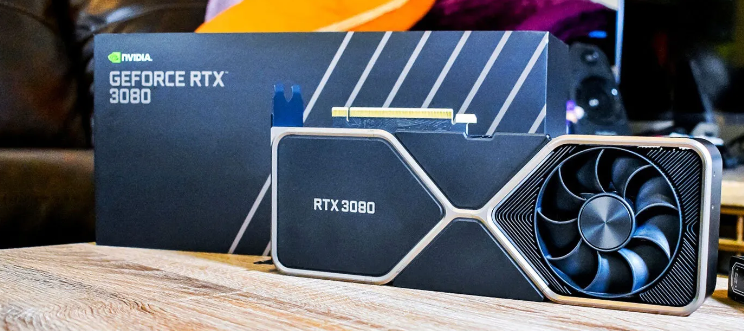NVIDIA RTX 3080 Review: Best 4K Gaming GPU for Gamers and Creators
NVIDIA RTX 3080 is a powerhouse GPU that brings high-end gaming and content creation to new heights. Thanks to its advanced Ampere architecture, this GPU has set new standards for both gaming enthusiasts and professional creators. Whether you’re gaming at 4K, working on creative projects, or delving into AI-based tasks, the RTX 3080 ensures optimal performance.
Key Specifications of the NVIDIA RTX 3080
Here’s a quick overview of the specifications that make the NVIDIA RTX 3080 stand out:
| Boost Clock | 1.71 GHz |
| CUDA Cores | 8704 |
| Memory (VRAM) | 10 GB GDDR 6X |
| Memory Speed | 19 Gbps |
| Ports | HDMI 2.1, 3x DisplayPort 1.4a |
| Power Consumption | 320W |
| Recommended PSU | 750W |
| Specifications | Details |
The RTX 3080 comes equipped with a high-performance memory architecture that allows it to handle intensive tasks, including 4K gaming and creative rendering. The HDMI 2.1 support is a standout feature for those who are into high-refresh-rate 4K gaming.
Gaming and Performance Benchmarks: 4K Gaming Excellence
The RTX 3080 shines when it comes to 4K gaming. Below are benchmark results for popular AAA games, demonstrating its superior gaming performance:
NVIDIA RTX 3080 FPS Benchmarks for Popular Games
- Cyberpunk 2077 (Ultra Settings, 4K, Ray Tracing & DLSS): 65 FPS
- Red Dead Redemption 2 (Ultra Settings, 4K): 70 FPS
- Assassin’s Creed Valhalla (Ultra Settings, 4K): 62 FPS
- Control (Ultra Settings, 4K, Ray Tracing): 55 FPS
- Call of Duty: Warzone (Ultra Settings, 4K): 90 FPS
These numbers highlight the RTX 3080’s ability to provide smooth gameplay even with ray tracing enabled. The inclusion of DLSS (Deep Learning Super Sampling) further enhances the gaming experience by using AI to upscale graphics efficiently.
Ray Tracing and DLSS Technology: The Future of Graphics
Ray Tracing Performance with NVIDIA RTX 3080
Ray tracing offers the most realistic lighting, shadows, and reflections in games, and the RTX 3080 is equipped with dedicated RT cores that handle ray tracing seamlessly. Games like Cyberpunk 2077 and Control exhibit lifelike visuals that were previously impossible to achieve at high frame rates.
How DLSS Enhances the Gaming Experience
DLSS technology is a game-changer for gamers who want better performance without compromising on quality. By using AI to render images at a lower resolution and then upscaling them, DLSS boosts frame rates, making demanding games more playable at higher resolutions like 4K. The DLSS 2.0 update improves upon this by further enhancing frame rates while maintaining excellent visual fidelity.
Power Consumption and Thermal Performance: Efficient Cooling with High Power
Power Consumption
The RTX 3080 has a power consumption of 320W, which is quite high compared to previous generations. As a result, a 750W PSU is recommended. However, despite its power demands, NVIDIA has integrated an effective cooling system that keeps temperatures under control.
Idle and Load Temperatures
- Idle Temperature: 38°C
- Load Temperature (Gaming): 70°C
- Load Temperature (Ray Tracing): 75°C
The cooling system is efficient enough to keep the RTX 3080 relatively quiet, even under load, and ensures that it maintains stable performance during prolonged gaming sessions.
Comparison with Competitors: RTX 3080 vs AMD RX 6800 XT and RTX 3070
In the high-end GPU market, the RTX 3080 faces tough competition from the AMD RX 6800 XT and RTX 3070. Let’s break down how it stacks up.
RTX 3080 vs RTX 3070
While both GPUs are part of NVIDIA’s Ampere architecture, the RTX 3080 offers better performance at 4K resolutions. Games like Cyberpunk 2077 and Assassin’s Creed Valhalla run significantly better on the RTX 3080, achieving higher frame rates compared to the RTX 3070.
For gamers looking to play at 1440p or 1080p, the RTX 3070 is a great choice, but if you’re targeting 4K gaming, the RTX 3080 is the way to go.
RTX 3080 vs AMD RX 6800 XT
The RX 6800 XT is a worthy competitor, offering 16 GB of GDDR6 memory. However, the RTX 3080 is superior when it comes to ray tracing and DLSS support. If you’re looking for raw performance, the RX 6800 XT is a solid option, but for those who care about cutting-edge gaming visuals and features, the RTX 3080 stands tall.
Pros and Cons of NVIDIA RTX 3080
Pros:
- Excellent 4K gaming and creative performance
- Superior ray tracing and DLSS support
- Highly efficient cooling system
- HDMI 2.1 support for high-refresh-rate 4K gaming
- Great for both gaming and content creation
Cons:
- High power consumption (750W PSU required)
- Expensive, especially with current market demand
- Availability issues due to supply shortages
Current Pricing and Availability: Is the NVIDIA RTX 3080 Worth It?
At launch, the RTX 3080 was priced at $699, but due to high demand and supply shortages, prices have surged. Currently, you can expect to pay over $1,000 for some models. Availability remains scarce, and retailers are selling out quickly.
Despite its high cost, the RTX 3080 offers unmatched performance, making it a valuable investment for gamers and creators. It provides future-proof capabilities, ensuring that you won’t need an upgrade for years to come.
For detailed pricing trends and where to buy, check out our GPU price trends.
Final Verdict: Should You Buy the NVIDIA RTX 3080?
If you’re looking for the best 4K gaming GPU, the RTX 3080 is undoubtedly one of the top choices. With exceptional performance in ray tracing, DLSS, and high-refresh-rate gaming, it is a future-proof investment for serious gamers and content creators.
Despite the high price and power consumption, the performance justifies the investment, especially for those who want the best in gaming and creative work. Whether you’re rendering high-resolution content or enjoying the latest AAA titles, the RTX 3080 delivers unparalleled results.
For more reviews on the best gaming GPUs, visit our GPU review







































